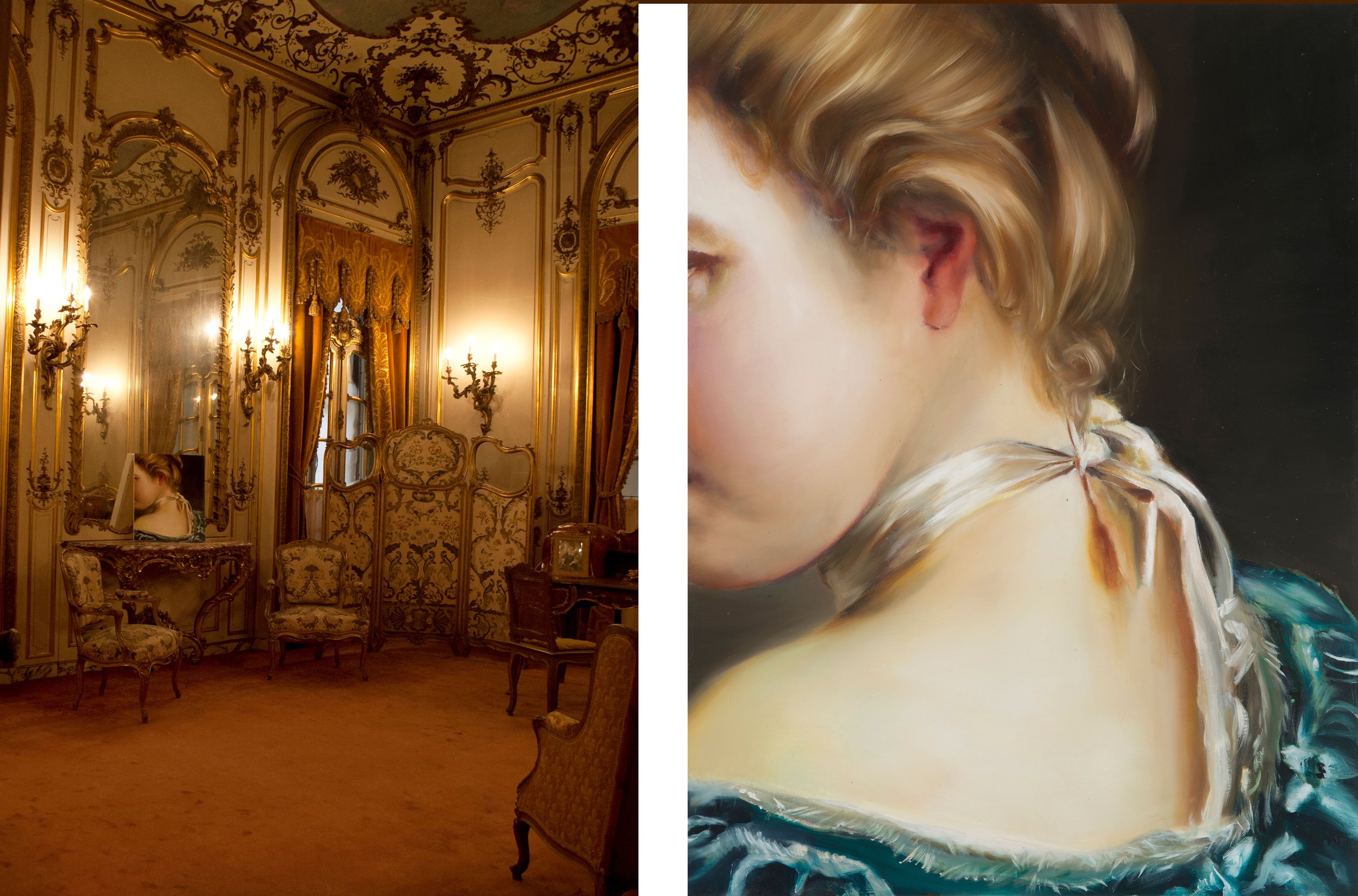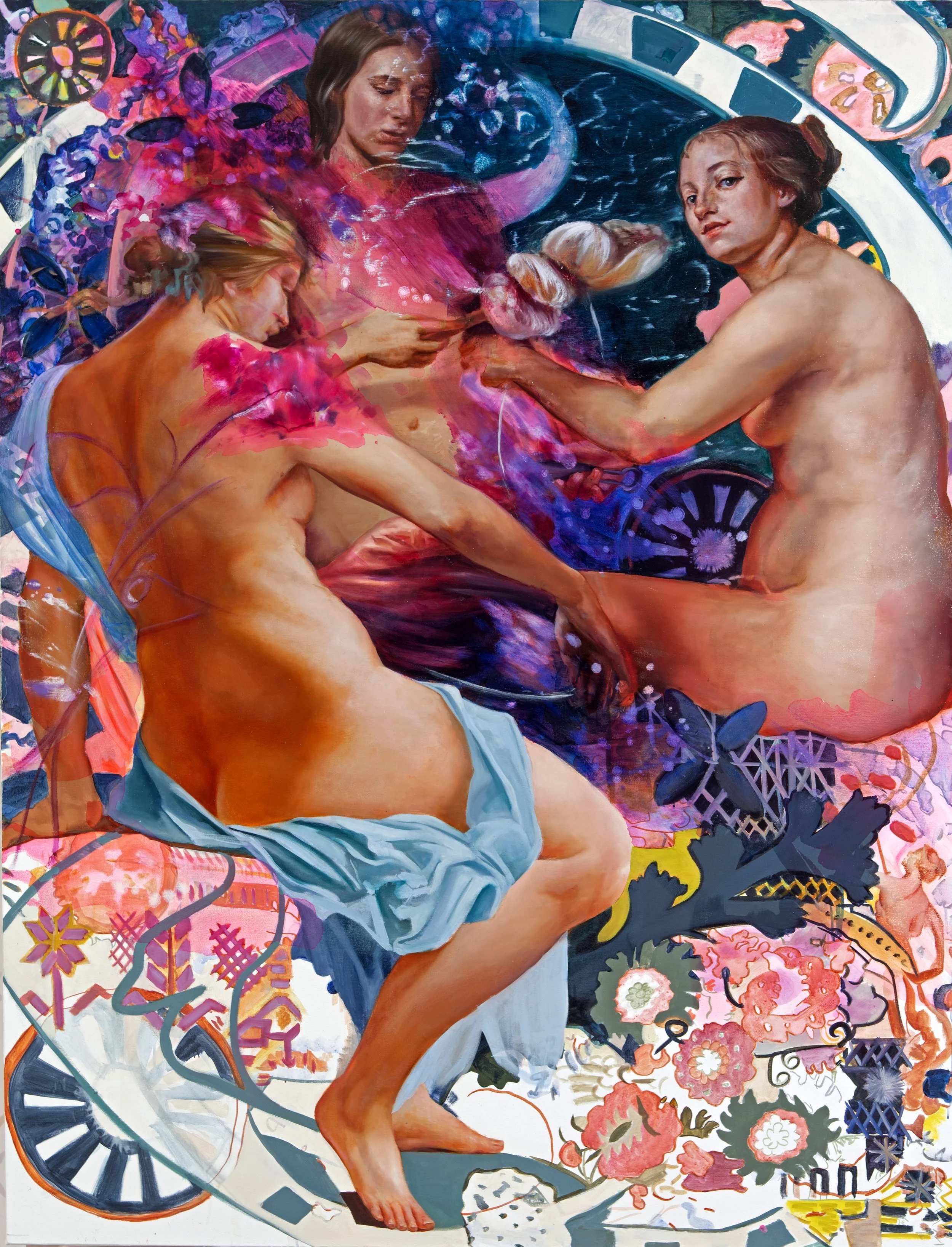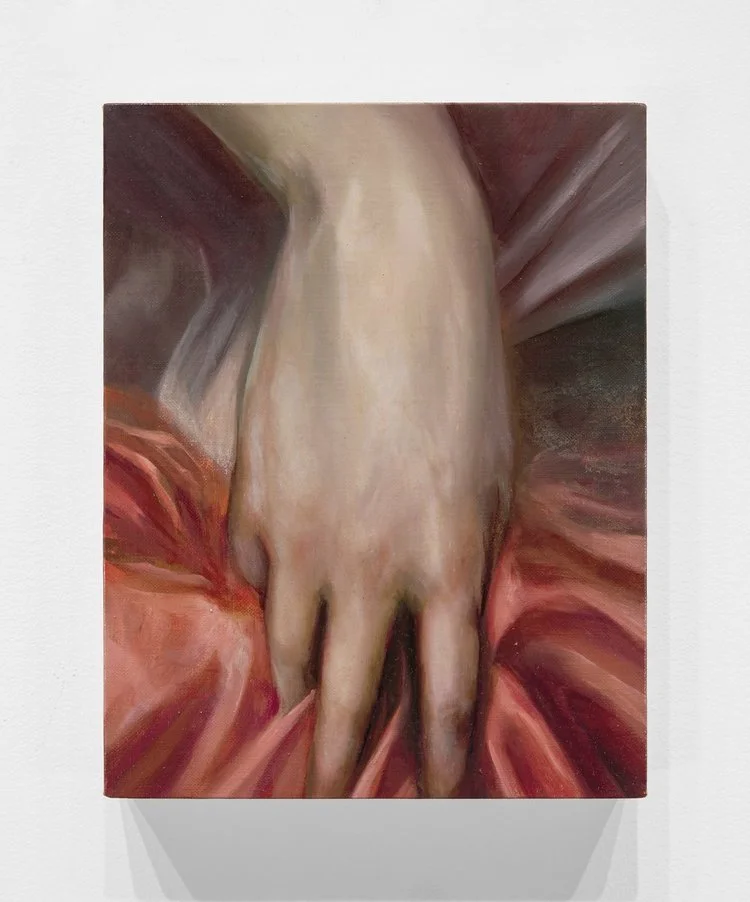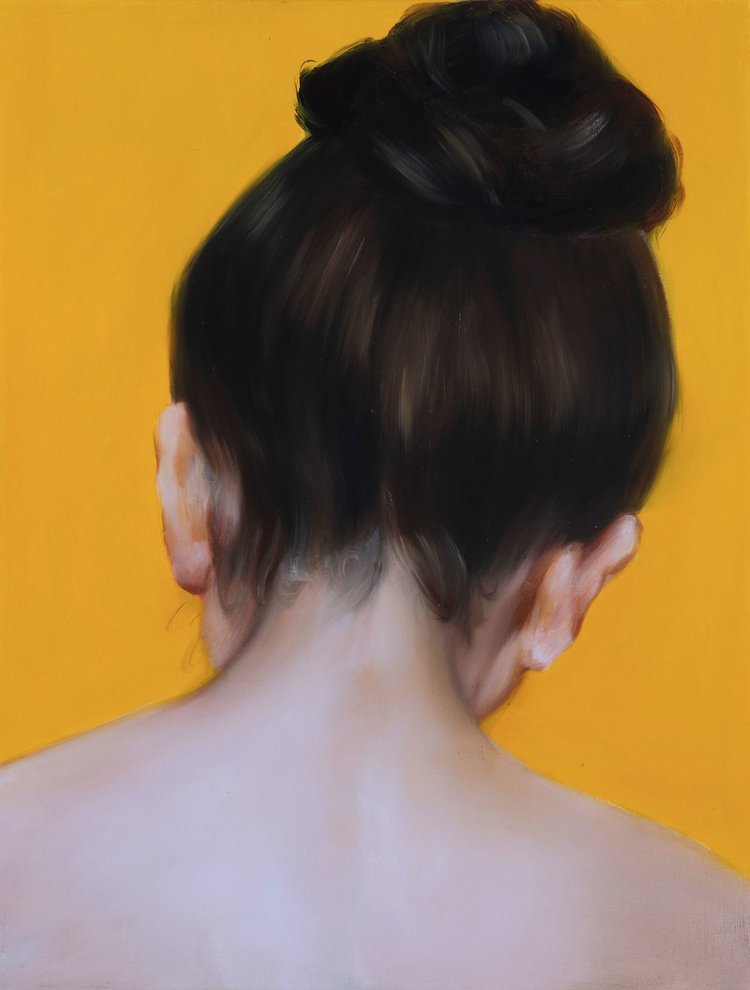Hot Coffee with American artist Angela Fraleigh
It is always interesting to meet and talk to an artist who considers the complexity of art history and contextualizes their practice within a given historical and socioeconomic moment. Angela Fraleigh’s site-specific solo show at the Allentown Museum, Pennsylvania Threaded with Moonlight is on view through April 21. And it gave me a chance to ask the artist some questions I had as I followed her practice over time. There is something sumptuous and yet, mysterious in her (literally and metaphorically) spell-binding works.Fraleigh’s long-term engagement with the theme of women as half-mythical, half-real creatures with powers to transform, to seduct, to destroy and to regenerate gives viewers an opportunity to think of her protagonists in analytical manner, but also use their intuition. Bridging academic and conceptual approaches to representation Fraleigh presents perspectives, not outcomes.
Nina: Imagine you are in your favorite coffee or tea spot. Where is it? What are you drinking? What are the three things you see right now?
Angela Fraleigh: Normally it would be at home, first thing in the morning when everyone is still asleep, but we’re in the middle of a major renovation on our home so we have construction dust everywhere, and a regularly changing landscape where my two kids plant little forts all around the house because they don't yet have bedrooms.
As a result, the coveted morning caffeine is for survival purposes only and my current quiet alone time drink happens at the studio around 3 pm. I’ve been on an Irish breakfast tea and oat milk kick after a trip with a friend to the UK last year; but I just returned from Italy after taking a study abroad group over spring break so now I’m hunting down the perfect espresso machine while making do with an AeroPress and a memory.
As I write this, I see a new “spell painting” I’m working on involving Cleopatra and snakes, a mountain of books on textiles, the witchhunts and witchcraft, and outside of my window a view of the six-pack shop where a cast of characters happily parade by to get their daily beverages.
Angela Fraleigh, Lost in the Light, Vanderbilt Mansion Historic Museum, Hyde Park, NY, October 9, 2015–May 25, 2016. Installation view courtesy of the artist.
Nina: Please tell me more about your ongoing exhibition at the Allentown Art Museum, Pennsylvania. What prompted this exhibition?
Angela: In my work I often examine the relationship between stories and beliefs, dominant narratives and cultural power dynamics, mythologized heroes, and contemporary values. I’m interested in how historical narratives, and the images that accompany them, express and influence beliefs about contemporary women and gender–and how we might upset those beliefs in favor of a more complex, inclusive lineage. Over the last decade, I have worked with many institutions to create several site-specific solo exhibitions that reveal alternative accounts in their permanent collections. In rearranging the images of the past, I hope to transform how we see ourselves in the present.
Threaded with moonlight, is a site-specific solo exhibition inspired by the Allentown Art Museum’s rich textile holdings and the long history of textiles as a medium associated with female labor. For this project I drew from ongoing research on the legacy of the witchunts coupled with traditions from across centuries and cultures, honoring women’s labor and examining the possible communications, intentions, and invocations embedded in their work. In these works, I center women as makers with the potential to craft meaning and magic as well as cloth. I created a trio of large-scale paintings and accompanying suite of small works that explore textiles as talismans and textile-making as acts of power.
Angela Fraleigh, Threaded with moonlight, 2023. Acrylic, watercolor, oil, amethyst, lapis lazuli, hematite, and jade on canvas.
Nina: Could you pick one work currently on view and zero in on it.What is it called? What influenced you when you were working on it?
Angela:The female figures in this trio of paintings (photographed below) evoke the Fates or Norns, the goddesses who spin to determine destiny in Greek and Norse tradition. Yet these figures might also be human women, engaged in the everyday work of textile production—labor that, with its divine associations, offered an opportunity to harness supernatural power.
The paintings are layered with global textile designs traditionally used to invite blessings, protection, or abundance—positioning these patterns not only as a complex subversive language, but also powerfully charged and charmed.
The paintings depict women holding distaffs, manipulating thread into cloth and lace, and wielding shears—mundane tasks that could potentially invoke potent forces. In folk religions across Europe, goddesses spin, measure, and cut thread to determine the span of a human life, while cultures worldwide draw parallels between female deities making textiles, the creation of the universe, and destiny. Informed by folklore, diverse spiritual practices, and textile traditions from across four continents and sixteenth centuries, Threaded with moonlight disrupts the docile femininity usually associated with textile work. These women seize the everyday rhythms of spinning, stitching, and weaving as ritual and incantation—transforming their work into a space for communication, harnessing power, and forging new possibilities.
I’ve long been interested in what power people have available to them and how they use that power. Steganography is the practice of hiding information in plain sight. After discovering the symbolic meanings of textiles within the collection, I integrated these coded patterns and various symbols into my work with the aim of crafting a powerful space imbued with magical potential. I selected textile motifs based on their traditional meanings and invocations: for instance, flowers, woven and embroidered worldwide to invite fertility and abundance; and stars, a symbol of celestial harmony and the passage of time. Other textile designs used here include labyrinthine patterns intended to confuse evil spirits, and geometric motifs used to offer strength and protection. To the experienced, such intentions are known; to others the implications remain hidden in plain sight. I love the way this plays with the notion of subversive decor and helps shed light on language as a perceptual domain exploring how images and ideas intersect and experiments with how meaning is made and beliefs are constructed.
Building on the layers of meaning embedded in the work, I incorporated moon water, ground crystals, and paint made from gemstones that hold supernatural significance in various traditions. Even the word “spell” has an expansive etymology, translating to narrative, fable, or cause of enchantment. For better or worse we draft our futures through the stories we tell. In this way, my work serves as a kind of counter-spell that disrupts, re-imagines and re-signifies history.
Angela Fraleigh, Installation view Threaded with Moonlight. Allentown Art Museum,Allentown, PA. November 11, 2023 – April 21, 2024. Photo courtesy of the artist and the museum.
Nina: How does this show fit the overall direction of your artistic practice?
Angela: I have spent my career exploring hierarchical patterns within narrative art, observing how images and roles from Western art history intersect with contemporary representation and attitudes. I uncover why certain tropes remain relevant, who they benefit, and how.
This project helped to underline again how, despite decades of feminist influence, there persists a gendered assumption that making important things is only to be found within the male domain. Splicing, spinning, binding, plaiting, and weaving have been fundamental to human civilization for millennia, long before the emergence of other technologies. Recently, spun fibers dating back nearly 30,000 years were discovered in present-day Georgia and we know textiles have been used to clothe people for over 10,000 years, with the creation of intricate fabrics predating the development of pottery and metalworking. The practices of spinning and weaving, which involve intertwining systems to create a cohesive whole, not only enabled the production of textiles but also provided early foundations for mathematics, music, and cosmology.
Historically, our understanding of women's activities often stems from documents detailing what they were forbidden to do. For example, medieval Pentecostal religious journals forbid women from hanging amulets on their looms, singing into their work, or performing rituals, incantations, or blessings. These prohibitions suggest that such practices were indeed part of women's activities. Scholars have also recently uncovered the relationship between the distaff and sacred rites, respected leaders/ healers and shamans were buried with their distaffs highlighting the cultural reverence for the act of spinning and the mystical, spiritual ties the act may have held.
The exhibition is informed by folklore, diverse spiritual practices, and textile traditions to disrupt conventional narratives and offer alternative, empowering visual stories. I came to folk religions/ traditions through the study of “the witch”. In tracing the historical trajectory of the witch, it becomes apparent that the connections between this archetypal figure and prevailing systemic power structures, such as capitalism, organized religion, and the patriarchy, are both profound and acutely relevant in our contemporary context. These connections are intrinsically tied to issues of female empowerment, bodily autonomy, and Persecution.
Silvia Federici, in her seminal work "Caliban and the Witch," persuasively argues that the medieval witch-hunts that swept across Europe played a pivotal role in the emergence of Capitalism, in fact, were a pre-condition. The portrayal of witches as malevolent maternal figures, heretics, and sexual deviants was a set of accusations strategically wielded by a patriarchal structure intent on subjugating women who dared to deviate from increasingly conservative paradigms governing women's roles in society. Many women-led activities and folk religions and traditions were declared illegal, and any gathering of women became synonymous with nefarious intentions. The propaganda orchestrated by political entities, which exploited religion and faith-based groups to maintain their positions of authority, resonates eerily with contemporary parallels.
Angela Fraleigh, A memory from a time you felt content ( A spell to induce tenderness), 2022. Oil and amazonite on linen, 14" x 11”. Photo courtesy of the artist.
Nina:As an artist you work with a crossover between representation and abstraction. How did you develop this approach?
Angela:I first began exploring the intersection of representation and abstraction during my residency at the CORE program in Houston, TX. I had been working with the paintings on the floor, while experimenting with different mark-making techniques. After a frustrating critique with a beloved mentor, I poured a copious amount of paint and medium onto the canvas and stepped away. Returning the next day, I was amazed by the transformative effect: the paint had broken down some figurative elements while highlighting others, leaving behind a mesmerizing, textured surface. Conceptually this process allows the paint to function as a protagonist in whatever narrative might be present. The physicality of the paint seemed to both canker and cover, meaningful passages, often exposing the fissures that occur when the ideals from one point in history are translated into another. Since then, I've been incorporating various forms of abstraction into my practice.
Angela Fraleigh, Petunias, Larkspur and The Picnic,2018. Oil on linen over watercolor and gouache on phototex, 20" X 16”. Edward Hopper House Museum and Study Center, NYACK, NY.Photo courtesy of the artist.
Nina: Why do you think we see so much figurative art throughout the art system today?
Angela: I’m sure there are many reasons for this, but in general I think figuration becomes more popular when we're culturally navigating through periods of political unrest and it seems like the role of art as a reflective mirror of societal conditions becomes particularly pronounced. I suppose figurative art serves as a conduit of sorts, allowing artists to challenge existing narratives and insert previously overlooked perspectives into the cultural discourse. Representation matters and I think when there is a sense of urgency, figuration allows for a perhaps more direct avenue to redefine and amplify underrepresented voices; to diversify artistic narratives and challenge the traditional canon. Figurative art can be a means of asserting agency and reclaiming space within the art world.
Further, I think there is often just a simple human desire to see people. Someone to think about. Someone to relate to, to want, to fear, to imagine, to converse with. We are meaning making machines. Looking is a powerful act that has not always been a luxury afforded to all. Looking at others allows us to witness, experience and perhaps contain, possess or overpower the things we see, the things that are hard to look at or hard to understand.
Angela Fraleigh, A late frost drifted back,2015. Oil on Canvas. 24 X 18”. Photo courtesy of the artist.
Nina: Some of your works are clearly influenced by Renaissance and XIX century schools of realism. In that golden age of painting younger artists learned from the masters by attending their studios for years. Do you think this type of influence helps artists as we now see many works with more conceptual premise rather than with skilled execution?
Angela: In my work I’m purposefully culling particular kinds of bodies, from particular time periods, to highlight invisible histories and dormant narratives, but I get what you’re asking.
I’m not sure. I mean I teach this way to some degree but I’m not sure if its helpful. I think you have to start somewhere. You have to know what you like or dont like and words dont teach, only life experience does.
I went to Boston University for my undergraduate education and at the time the curriculum was academic in its design. We painted, sculpted and drew from life 30+ hours every week. I loved it. There is something meditative and magical about the process for me. It requires rigor, stamina and focus. I teach this approach myself albeit with much less time of a time commitment, because I think developing observational skills, learning to see, becoming familiar with the formal elements and principles of design, these help form a language or perhaps a set of rules to break later.
During my time at Yale, which placed much more emphasis on the conceptual, I questioned whether my focus on figurative painting stemmed from a real love for the subject or if was a direct result of rigid training. I envied peers who seemed to approach art with a fresh perspective, unencumbered by the pursuit of mimetic accuracy. Now, I suppose my artistic practice is kind of an obvious merging of my two wildly different educational experiences but I've come to understand that artistic desires and influences are often beyond our control. We don't necessarily choose what inspires us or what direction our work takes. Sometimes it’s just a path you can’t not do. So, I try to offer as many different approaches to working as I can for my own students and hope that they find the thing that they can't not do through the process.






